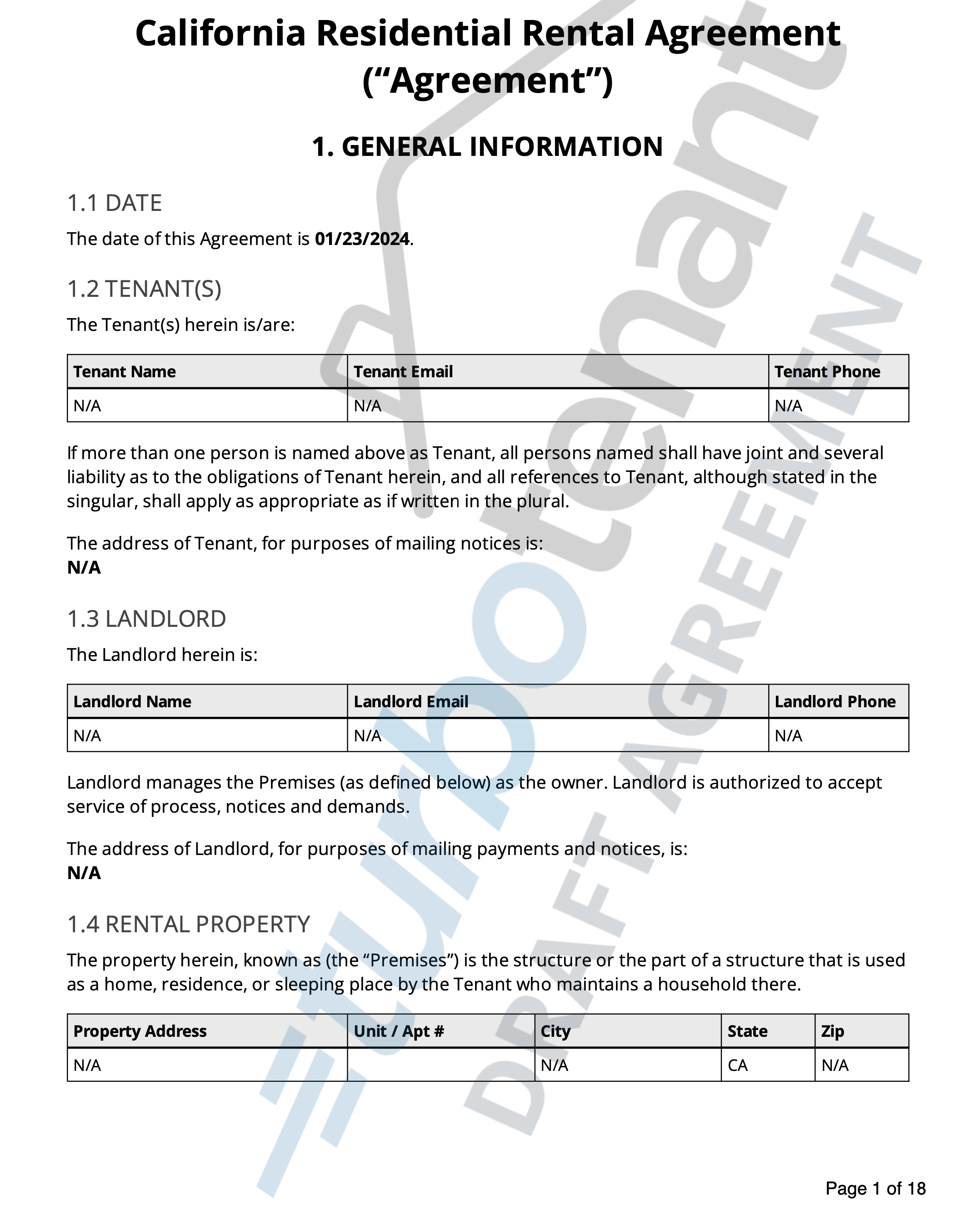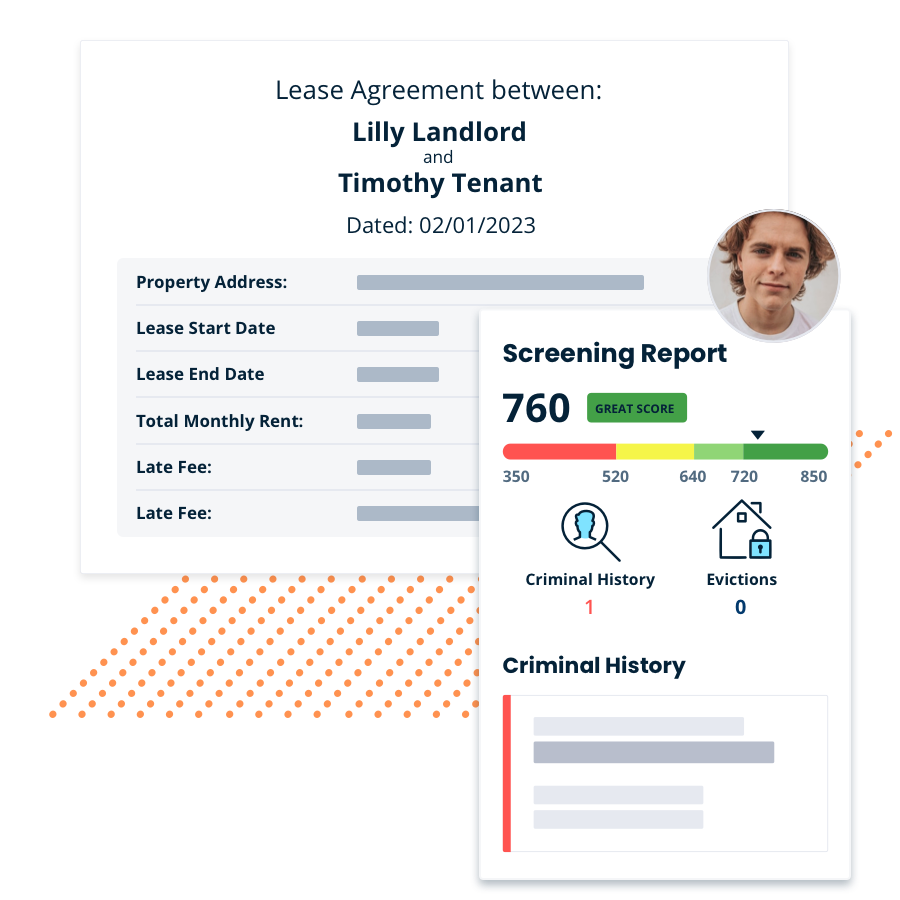Table of Contents
Key Takeaways
- Detailed tenant, landlord, and property information, plus specifics on rent amounts and utility responsibilities
- Customizable sections for property-specific rules and necessary California legal clauses
Clear policies on key return, late rent fees, and security deposit return as per California law - Defined occupancy limits for tenants and guidelines for guest visits
Allocated responsibilities for property repairs, maintenance, and notification procedures - Stipulations on landlord’s right to access the property and protocol for tenants changing locks
- Conditions and permissions related to subletting and making alterations or improvements
- Compliance with mandatory California disclosures and statewide landlord-tenant laws

Custom Lease
Section 1 is tailored to include information about you, your tenants, the rental property, and the lease details. You input this information through TurboTenant’s lease creation process. It includes the main details of the lease, such as who is on the lease, rent amount, utility responsibilities, and more, which are summarized at the beginning of the lease agreement for easy reference.
Additional Provisions
Here, you can include property-specific rules, necessary local clauses, or other details unique to your situation. Although this section offers customization, it is recommended to have these additional provisions reviewed by a legal professional.
Lost Key
This section outlines the tenant’s responsibility to return all keys upon moving out. If they fail to do so, they are liable for the cost of rekeying the property.
State-Specific Clauses
Section 2 comprises clauses that are specific to California law, aimed at keeping you within legal boundaries. Notably, details in this section are not editable to ensure compliance, with the exception of certain disclosures.
Late Fees
It specifies that rent is due on the first of each month, with a grace period until the fifth. If rent is not paid in full by then, you are entitled to charge a late fee as defined by the lease terms.
Security Deposit Provisions
California law requires that the security deposit be returned within 21 days of the lease’s end, less any deductions for damages or unpaid rent. Interest on security deposits is not mandated unless specified by local law.
Occupancy Limits and Guests
The lease stipulates who may legally occupy the premises, typically limited to the tenant and any additional occupants listed, like dependents.
Notification of Repairs
Tenants are responsible for repairs stemming from misuse or negligence and must promptly report any serious property issues to the landlord. Conversely, landlords must address necessary repairs to maintain a safe and habitable environment.
Access to Premises by Landlord
The lease outlines the conditions under which a landlord may enter the property, including emergencies and maintenance.
Changing Locks
Tenants must request in writing if they wish to change locks and must bear the cost, even though the installation may be performed by the landlord.
Disclosures
The lease includes mandatory California disclosures, such as asbestos, methamphetamine/fentanyl, flood zones, prior deaths, military testing sites, shared utilities, and bed bug information.
California Counties
Here is a list of some counties in California, highlighting unique clauses that may be present due to local regulations:
Los Angeles County
- Strict rent control and stabilization ordinances in cities like Los Angeles.
- Detailed security deposit and return regulations.
San Diego County
- San Diego’s regulations on notice periods for rent increases and lease terminations.
- Ordinances pertaining to short-term rental properties.
Orange County
- Local city codes within the county may impact lease terms, such as in Anaheim or Santa Ana.
- Clauses for rental property standards and tenant protections.
Riverside County
- Riverside’s requirements for rental unit inspections and maintenance.
- Specific regulations on occupancy limits and housing quality standards.
San Bernardino County
- San Bernardino’s housing codes that could necessitate additional lease provisions.
- Ordinances on rental property registration and safety requirements.
Santa Clara County
- San Jose’s tenant protection ordinances, including rent control measures.
- Regulations on energy efficiency disclosures.
Alameda County
- Oakland’s strong rent control laws requiring specific lease terms.
- Detailed tenant relocation assistance stipulations.
Sacramento County
- Sacramento’s rental housing inspection program and associated lease clauses.
- Regulations on property maintenance and tenant health and safety.
Contra Costa County
- Local regulations in cities like Richmond affecting lease agreement terms.
- Clauses related to property inspections and safety codes.
Fresno County
- Fresno’s local ordinances on rental property conditions and habitability.
- Specific clauses for handling of security deposits and evictions.
Landlords in California must navigate a complex array of state and local laws when drafting lease agreements. It’s essential to be well-informed about the specific ordinances in each county, as they can introduce unique requirements to lease agreements. Legal consultation is recommended to ensure full compliance and protection for all parties involved.
General Things to Know
This section contains general clauses common to most lease agreements across the United States, following best practices for the landlord-tenant relationship.
Subletting
Tenants are prohibited from subleasing the property without the landlord’s written permission.
Altering or Improving the Property
Tenants must obtain written consent before making any alterations or improvements to the property.
Follow the Law
Tenants must adhere to all applicable laws and ordinances and avoid being a nuisance to neighbors. Breaches can be grounds for lease termination.
Helpful Things to Know About California Landlord-Tenant Law
California sets limits on the amount that can be charged for security deposits, which varies depending on whether the property is furnished or unfurnished and if the tenant is a service member. Local laws may also require interest to be paid on these deposits.
Security Deposit Return
Landlords have a 21-day window to return the security deposit, provide an itemized list of deductions, and issue any remaining refund along with the necessary receipts, unless repairs are under a certain dollar amount or the tenant has waived their right to receive them.

FAQ
What is the maximum amount I can charge for a security deposit in California?
In California, landlords can charge up to two months’ rent for an unfurnished rental and three months’ rent for a furnished rental. For service members, the limit is one month’s rent for unfurnished and two months’ rent for furnished rentals. An additional half month’s rent may be charged if the tenant has a waterbed.
How long do I have to return the security deposit to the tenant after they move out?
Landlords in California must return the security deposit within 21 days of the tenant moving out. This includes providing an itemized statement of deductions for damages or unpaid rent and receipts for deductions exceeding a specified amount, unless the tenant waives this right.
Are there any specific disclosures I need to include in my California lease agreement?
Yes, there are mandatory disclosures required in California lease agreements. These include information regarding asbestos, methamphetamine or fentanyl contamination, flood zones, previous deaths on the property, military testing sites nearby, shared utilities, and bed bug infestations.


